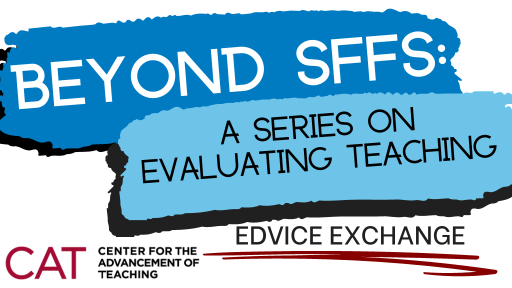Stephanie Laggini Fiore, Ph.D.

Evaluation without development is punitive, and development without evaluation is guesswork. (Theall, 2017)
Lee Shulman, past president of the Carnegie Foundation for the Advancement of Teaching and professor emeritus at Stanford University, recounts his surprise that his vision of faculty life as a combination of quiet, solitary scholarly activity and vibrant, collegial interactions with a community of teachers was backward. Says Shulman (1993), “We close the classroom door and experience pedagogical solitude, whereas in our life as scholars, we are members of active communities: communities of conversation, communities of evaluation, communities in which we gather with others in our invisible colleges to exchange our findings, our methods, and our excuses.” In fact, when I speak with faculty about the possibility of implementing new methods of teaching evaluation (such as peer review) that will break down that isolation and begin to develop synergies among faculty for development in teaching and learning, they may fall prey to imposter syndrome, claiming not to be expert enough to provide feedback to colleagues. At the same time, they reveal a sense of vulnerability at the idea of having others observe their teaching.
But a remarkable thing happened during the shift to remote learning during COVID-19. Faculty began to emerge from their isolation, connect with each other to talk about teaching and brainstorm together solutions to teaching challenges. New Facebook pages dedicated to pedagogy sprang up (the Pandemic Pedagogy group has 31K followers), national disciplinary organizations put information on their websites and circulated it through listservs, department meetings were dedicated to teaching and learning, faculty spoke with students about what worked. In short, because we were pushed into the deep end without a lifejacket, we focused our attention on teaching. And we grew by learning from each other and from our students!
Evaluation of teaching has long been practiced as a mechanism for summative decisions regarding promotion or contract renewal, and faculty will complain (often rightfully so) that it can be either a checkbox exercise devoid of real meaning or based heavily on student feedback. Evaluation of teaching should be so much more! It should create the kind of community that the pandemic briefly afforded us, one in which we as professionals reflect on our own teaching, discuss our practices with colleagues, learn from each other, from our students, and from how well students meet our learning goals, and move towards continual, formative improvement. Stephen Brookfield (2005) suggests that we look at our teaching through four lenses: an autobiographical lens, our students’ lens, our colleagues’ lens, and the lens of theoretical literature. We might also think about how we assess whether our students are reaching the learning goals we’ve set out for them, and what changes we might make to try to improve their ability to succeed in our courses. As Berk (2018) points out, multiple sources can be both more accurate and more comprehensive in evaluating a professional activity as complex as teaching. These multiple sources can be deployed for summative purposes, of course, but more importantly, they can be useful as a holistic tool to help us continue our growth as educators, and our effectiveness in supporting student learning.
We already have a long history of employing the student lens through student feedback forms (SFFs) so this series will not separately discuss this method of evaluation. However, I will mention here how important it is to be mindful of best practices in using SFF data in order for it to provide helpful information towards improvement of teaching. The Temple University Assessment of Instruction Committee has just put out a very helpful guide to using SFF data, Recommendations for the Use of Student Feedback Form (SFF) Data at Temple University. This comprehensive guidance includes a good overview on the purpose of SFFs, what they are and are not, advice for instructors on how to use SFF data, and advice for evaluators on how to use SFFs responsibly and effectively for evaluation purposes. See also How to Read Those SFFs and Flip the Switch: Making the Most of Student Feedback Forms for guidance on the best ways for faculty to use student feedback to improve teaching. And, of course, you can make an appointment with a faculty developer at the CAT to discuss your SFFs.
Remember also that SFFs are not the only way to receive student feedback. I strongly recommend gathering mid-semester feedback as a check-in with your students while there is still time to make changes in the semester. It has the added bonus of having students reflect on their learning and consider changes they may want to make in order to achieve better results. You can also ask the CAT to perform a mid-semester small (or large) group instructional diagnosis.
This blog series will continue throughout the fall semester with an exploration into the other teaching evaluation methods that can be used to both assess teaching practices and grow teaching excellence. Stay tuned for the following upcoming topics:
Part II: Reflective Practice
Part III: Peer Review of Teaching
Part IV: Assessment of Learning Outcomes
Part V: Literature on Teaching and Learning
At the end of this series, my sincerest wish for you is that you find new ways to think about your teaching practices, that you engage with your colleagues (and with the CAT!) in productive and enlightening conversations about teaching, that you find a favorite resource on teaching, and that you connect with your students in ways that help them to learn deeply.
Stephanie Fiore serves as Assistant Vice Provost of Temple’s Center for the Advancement of Teaching.